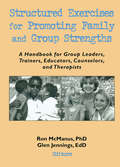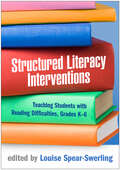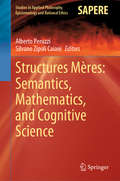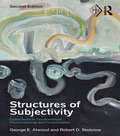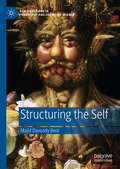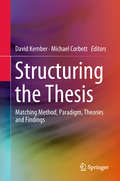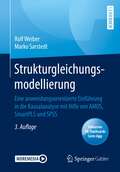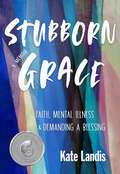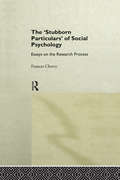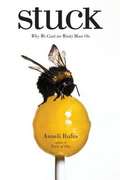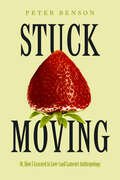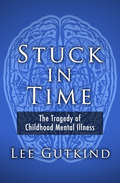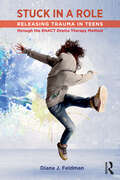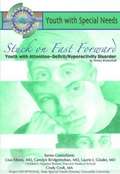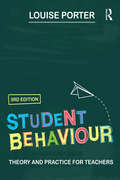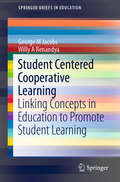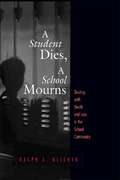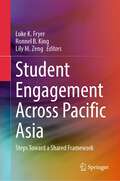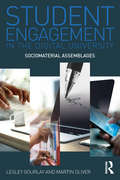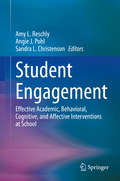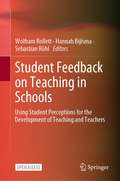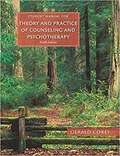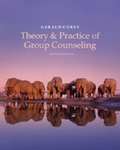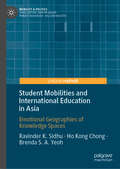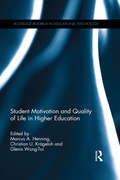- Table View
- List View
Structured Exercises for Promoting Family and Group Strengths: A Handbook for Group Leaders, Trainers, Educators, Counselors, and Therapists
by Terry S Trepper Glen H Jennings Ronnie McmanusThis handbook for professionals presents an array of techniques for teaching and reinforcing social skills for successful relationships. It contains over 70 new structured exercises that can be used to help individuals, dyads, families, and groups become happier in their relationships. The exercises come complete with step-by-step instructions for easy use. Structured Exercises for Promoting Family and Group Strengths is a goldmine of resources for group leaders and counselors. You can use it in planning and conducting workshops and retreats or for working with individuals or families in counseling. The book saves you time and energy as each exercise is accompanied by suggestions for procedures, variations, and trainer's notes. The exercises, which have all been field tested with a variety of audiences, are grouped into six broad categories:Icebreakers introduce people to the subject of group dynamics and to each other in a workshop setting.Assessors help people assess relationships and gain insight for constructive change.Dyad/couple discussion starters facilitate communication and open dialogue for dyads who find themselves in dysfunctional situations.Group/family discussion starters strengthen communication within groups or families and increase understanding of how the group functions.Enhancers aid in the development of positive regard of self and others.Energizers perk up the group or family when fatigue occurs.The exercises provide an experiential approach to learning in which each participant is actively and creatively involved. Readers will find that these relationship-enhancing exercises offer a catalyst for dramatic change in the lives of individuals, dyads, families, and groups. Structured Exercises for Promoting Family and Group Strengths is a valuable sourcebook of ideas for use by persons in the helping professions, including counselors, psychologists, marriage and family therapists, social workers, chaplains, corrections officers, and educators.<
Structured Literacy Interventions: Teaching Students with Reading Difficulties, Grades K-6 (The Guilford Series on Intensive Instruction)
by Louise Spear-SwerlingComprehensive and evidence-based, Structured Literacy (SL) approaches place a high value on explicit, systematic, and sequential instruction. This book brings together leading experts to present a wealth of SL interventions for different components of literacy. Chapters describe instructional strategies for supporting phonological awareness, basic and multisyllabic word decoding, spelling, reading fluency, vocabulary, oral and reading comprehension, and written expression, especially for at-risk readers and those with disabilities. Including case studies, sample intervention activities, lesson plans, and end-of-chapter application activities, the book contains reproducible tools that can be downloaded and printed in a convenient 8½&“ x 11&” size. An NCTQ Exemplary Text for Reading Instruction See also Louise Spear-Swerling's authored volume, The Structured Literacy Planner: Designing Interventions for Common Reading Difficulties, Grades 1–9, which provides blueprints for tailoring interventions based on a learner's reading profile.
Structures Mères: Semantics, Mathematics, and Cognitive Science (Studies in Applied Philosophy, Epistemology and Rational Ethics #57)
by Alberto Peruzzi Silvano Zipoli CaianiThis book reports on cutting-edge concepts related to Bourbaki’s notion of structures mères. It merges perspectives from logic, philosophy, linguistics and cognitive science, suggesting how they can be combined with Bourbaki’s mathematical structuralism in order to solve foundational, ontological and epistemological problems using a novel category-theoretic approach. By offering a comprehensive account of Bourbaki’s structuralism and answers to several important questions that have arisen in connection with it, the book provides readers with a unique source of information and inspiration for future research on this topic.
Structures of Subjectivity: Explorations in Psychoanalytic Phenomenology and Contextualism (Psychoanalytic Inquiry Book Series #4)
by Robert D. Stolorow George E. AtwoodStructures of Subjectivity: Explorations in Psychoanalytic Phenomenology and Contextualism, is a revised and expanded second edition of a work first published in 1984, which was the first systematic presentation of the intersubjective viewpoint – what George Atwood and Robert Stolorow called psychoanalytic phenomenology – in psychoanalysis. This edition contains new chapters tracing the further development of their thinking over the ensuing decades and explores the personal origins of their most essential ideas. In this new edition, Atwood and Stolorow cover the philosophical and theoretical assumptions of psychoanalysis and present a broad approach that they have designated phenomenological contextualism. This approach addresses personal subjective worlds in all their richness and idiosyncrasy and focuses on their relational contexts of origin and therapeutic transformation. Structures of Subjectivity covers the principles guiding the practice of psychoanalytic therapy from the authors' viewpoints and includes numerous detailed clinical case studies. The book will be essential reading for psychoanalysts, practitioners of psychotherapy, psychiatrists, psychologists, counselors, and social workers. It will also be of interest to scholars and students with an interest in psychoanalytic theory and practice, and its philosophical premises.
Structuring the Self (New Directions in Philosophy and Cognitive Science)
by Majid Davoody BeniThis book presents a unified account of the self, based on a network of knowledge sourced from several scientific accounts of selfhood. Beni constructs his ontological account of the self from the common structure that underpins the theoretical diversity that is manifested in rival and sometimes incompatible scientific accounts of the self and its aspects. The enterprise is inspired by recent structural realist theories in the philosophy of science, specifying the basic structure of the self, and explaining how representational, phenomenal, and social aspects of the self are embodied within this structure.
Structuring the Thesis: Matching Method, Paradigm, Theories and Findings
by Michael Corbett David KemberThe book is a collective investigation of the structuring of theses in education, the social sciences and other disciplines that commonly do not follow the standard procedures of the scientific method. To help research students design a structure for their own thesis and liberate their investigations from the constraints associated with the use of the conventional structure, it explains how the structures adopted were designed to suit the topic, methodology and paradigm. It also provides a wide range of examples to draw upon, which suit a broad spectrum of theory, methodological approaches, research methods and paradigms. Additionally, by analyzing the methodologies and paradigms, and reviewing the methodological and paradigmatic spectrum, it offers a significant contribution to the way research is conceptualized.The book addresses a number of key questions faced by students, supervisors and examiners: •Why do examiners often find it difficult to read work in non-scientific disciplines when theses are structured in accordance with the conventional scientific method?•Why do students in non-scientific disciplines struggle to write up the outcomes of their research in the conventional structure?•What alternative thesis structures can be devised to better suit the wide range of methods?•Which theories and paradigms are commonly followed in education and the social sciences and how do these perspectives influence the research process? •What methods, theories and paradigms are commonly adopted by education and social science students and what problems do these pose when students write their theses?
Strukturgleichungsmodellierung: Eine anwendungsorientierte Einführung in die Kausalanalyse mit Hilfe von AMOS, SmartPLS und SPSS
by Marko Sarstedt Rolf WeiberStrukturgleichungsmodelle stellen das Standardinstrument zur empirischen Prüfung von hypothetisierten Beziehungen zwischen theoretischen Konstrukten (latenten Variablen) dar. Das Buch zeichnet den gesamten Prozess der Strukturgleichungsmodellierung von der Konzeptualisierung theoretischer Konstrukte über die Spezifikation von Messmodellen, die Reliabilitäts- und Validitätsprüfung mittels konfirmatorischer Faktorenanalyse bis hin zur Prüfung von kausalen Wirkungshypothesen auf Basis der Kovarianzstrukturanalyse sowie der Partial Least Squares-Pfadmodellierung nach.Die einzelnen Analysen werden so erläutert, dass geringstmögliche mathematische Vorkenntnisse erforderlich sind. Alle Arbeitsschritte werden an einem durchgehenden Fallbeispiel unter Verwendung von SPSS, AMOS und SmartPLS veranschaulicht. Zu allen Arbeitsschritten werden klare Anwendungsempfehlungen sowie Hinweise zum Umgang mit unerwarteten Analyseergebnissen gegeben. Die Verwendung der jeweiligen Software wird ausführlich durch Screenshots erläutert. Für die 3. Auflage wurde das Buch umfassend überarbeitet, um die jüngsten methodischen Entwicklungen abzudecken. Besonderer Fokus wurde auf die Ausführungen zur PLS-Pfadmodellierung und Darstellung alternativer Schätzverfahren der Kausalanalyse gelegt. Das Angebot wurde zudem um digitale Lernkarten (Flashcards) erweitert, welche es dem Leser ermöglichen, das Wissen aus dem Buch zu vertiefen.Die ZielgruppenDas Buch richtet sich an Studierende und Lehrende in Master- und Doktorandenprogrammen sowie an Anwender aus der Unternehmens- und insbesondere Marktforschungspraxis. Es ist von besonderem Nutzen für alle, die Wirkungshypothesen zwischen latenten Variablen empirisch prüfen möchten. Das Fallbeispiel ist so allgemein gehalten, dass der Anwender die Analysen leicht auf spezifische Fragen und Probleme in seinen jeweiligen Anwendungsfeldern übertragen kann.Über die Internetseite www.strukturgleichungsmodellierung.de haben die Leserinnen und Leser Zugriff auf alle im Buch verwendeten Datensätze und Analyseskripte sowie weitere Serviceleistungen.
Stubborn Grace: Faith, Mental Illness, and Demanding a Blessing
by Kate LandisWith unflinching honesty and humor in the vein of Cheryl Strayed and David Sedaris but a raw tenderness all her own, Kate Landis chronicles the hardest parts of her young adulthood as well as her poignant journey to faith and community. Kate Landis grew up in the American Baptist Church—the child of a music director and a deacon—until she left the church in her late teens after surviving major depression and a handful of suicide attempts. She became an activist, feminist, punk, and self-described rabble rouser. And through activism she found a spiritual community with justice at its core and a faith that could hold it all—her mental illness, her fire, her spunk, and all of her questions—a loving, stubborn grace.
Stubborn Particulars of Social Psychology: Essays on the Research Process (Critical Psychology Series)
by Frances CherryThe `Stubborn Particulars' of Social Psychology gives students an alternative approach to social psychology which acknowledges the limits of shared understandings often imposed by class, race, culture, nationality, ethnicity, language and gender. Frances Cherry shows how the generation of hypotheses, experimental practice, the interpretation of results and the process of scientific communication itself are equally framed by historical and cutural context. She discusses how to begin to understand one's own biases and prejudices, and how we create and make sense of our own social psychology as an engaged social critic, rather than as some idealised `objective' scientist. The `Stubborn Particulars' of Social Psychology should be required reading for all social psychology students as an antidote to their course text.
Stuck
by Anneli Rufus"The brilliant mind behind Party of One examines the striking social trend: people are stuck and they want to change, but. . . " (San Francisco Chronicle) In this book, Anneli Rufus identifies an intriguing aspect of our culture: Many of us are stuck. Be it in the wrong relationship, career, or town, or just with bad habits we can't seem to quit, we even say we want to make a change, but . . . Merging interviews, personal anecdotes, and cultural criticism, Stuck is a wise and passionate exploration of the dreams we hold dearest for ourselves-and the road to actually achieving them. When faced with the possibility of change, our minds can play tricks on us. We tell ourselves: I can't make it. Or, It's not worth the effort. How is it that in a time of unprecedented freedom and opportunity, so many of us feel utterly powerless and unsure? In this book, Rufus exposes a complex network of causes for our immobilization- from fear and denial to powerful messages in popular culture or mass media that conspire to convince us that we're helpless in the face of our cravings. But there can be a light at the end of the tunnel: Rufus also tells the stories of people who have managed to become unstuck and of others who, after much reflection, have decided that where they are is best. After all, she writes, "what looks to you like a rut, others might say is true absorption in a topic, a relationship, a career, a pursuit, a place. What looks to you like boredom, others call commitment. And even contentment. " A brilliant glimpse into what truly motivates-or doesn't motivate-us, Stuck will inspire you to take a look at yourself in an entirely new light. .
Stuck Moving: Or, How I Learned to Love (and Lament) Anthropology (Atelier: Ethnographic Inquiry in the Twenty-First Century #9)
by Peter BensonThis one-of-a-kind literary and conceptual experiment does anthropology differently—in all the wrong ways. No field trips. No other cultures. This is a personal journey within anthropology itself, and a kind of love story. A critical, candid, hilarious take on the culture of academia and, ultimately, contemporary society. Stuck Moving follows a professor affected by bipolar disorder, drug addiction, and a stalled career who searches for meaning and purpose within a sanctimonious discipline and a society in shambles. It takes aim at the ableist conceit that anthropologists are outside observers studying a messy world. The lens of analysis is reversed to expose the backstage of academic work and life, and the unbecoming self behind scholarship. Blending cultural studies, psychoanalysis, comedy, screenwriting, music lyrics, and poetry, Stuck Moving abandons anthropology’s rigid genre conventions, suffocating solemnity, and enduring colonial model of extractive knowledge production. By satirizing the discipline’s function as a culture resource for global health and the neoliberal university, this book unsettles anthropology’s hopeful claims about its own role in social change.
Stuck in Time: The Tragedy of Childhood Mental Illness
by Lee GutkindA harrowing exploration of one of the country&’s most troubling hidden shames: the widespread neglect of disabled children by the institutions that have sworn to protect themFour-fifths of American children with serious mental health problems receive no professional treatment whatsoever. They are the product of an overextended and often neglectful system that, as Lee Gutkind writes, has reached the level of insanity. Following the stories of three children—Daniel, Meggan, and Terri—Stuck in Time chronicles the tragedies and injustices wrought not only by the deficiencies of the mental healthcare system, but by government policymakers who have failed to address the problem. Through these children and their families, Gutkind explores mental illness as both a scientific and social issue, from the harsh economic realities of supporting a disabled child to the immense difficulty of finding a suitable counselor.Written with passion and piercing detail, Stuck in Time is a poignant examination of three families fighting against impossible circumstances, and of a system too inflexible to accommodate the helpless victims it is meant to support.
Stuck in a Role: Releasing Trauma in Teens through the ENACT Drama Therapy Method
by Diana J. FeldmanStuck in a Role illustrates how adolescents, especially those who have experienced developmental trauma, can become “stuck” in protective roles that can distance them from their authentic selves, and how the ENACT Drama Therapy Method can help them break free from these confining roles.Using innovative methods of dramatic play, improvisation, and finely honed methods of communication, Feldman shares her unique method of drama therapy, developed over more than 30 years working in the NYC school system, as well as her moving and inspiring case histories.This book will support all professionals working with children and adolescents, including creative arts educators and therapists, psychotherapists, school counselors, parents, and teachers. It illustrates how to help teens learn crucial coping and relationship skills, moving them toward new and productive ways of being. Through compelling case histories based on Feldman’s work with thousands of adolescents labeled hard-to-reach, this book models empathy for youth behavior.
Stuck on Fast Forward: Youth with Attention-Deficit Hyperactivity Disorder (Youth with Special Needs)
by Shirley BrinkerhoffConnor didn't have too many problems before he started school. That is, if you don't count the little things, like the time he tried to mow the lawn with his dad's riding mower (he ruined the engine when he poured oil in the gas tank); or the time he dressed up like Santa Claus and tried to go down the chimney of the backyard brick barbeque (he got stuck and the fire department had to come pull him out); or the experiment he conducted on the family beagle to see if she liked Tabasco sauce on her dog food (the vet threatened to call the ASPCA). The real trouble didn't start until Connor began kindergarten. The notes started coming home with Connor on his very first day. They said things like: "Does not play well with others," "Is disruptive in class," and "Teacher requests conference with parents." Every day that Connor brought home another note--which was most days--his parents looked a little grayer and a little more tired. Connor couldn't seem to sit still or pay attention; and all too often, his impulsiveness led to inappropriate behavior. Though his parents do not know it yet, Connor has attention-deficit/hyperactivity disorder. ADHD is an increasingly common diagnosis for school-age and preschool children today. The debate over diagnosis and treatment of symptoms is intense. In Stuck on Fast Forward: Youth with Attention-Deficit/Hyperactivity Disorder, you will learn about the many sides of this common and controversial condition. Along the way, you will read more about Connor and how he and his family learn to live with the challenges of ADHD.
Student Behaviour: Theory and practice for teachers
by Louise PorterBehaviour management in the classroom and schoolyard is one of the most challenging aspects of teaching. Student Behaviour offers a comprehensive overview of the major theories of behaviour management in primary and secondary schools, illustrated with detailed case studies.Porter outlines how teachers can develop a personal approach to classroom management based on a sound understanding of theory. The emphasis is on proactive approaches to discipline to assist students in achieving educational and social goals. Porter also shows how to enhance students' motivation and help students become confident and independent learners. This third edition has been fully revised and updated to reflect the latest research, and includes new material on collaborating with parents, ethical issues, dealing with bullying and helping students to be autonomous in their learning and behaviour. Examples and references are drawn from current international research.Student Behaviour is an essential textbook for preservice teachers and a valuable reference for more experienced teachers who want to improve their ability to cope with disruptive behaviour. The style of writing is clear, accessible and authoritative an ideal text for all teachers in initial and post-experience training. It treats its audience as intelligent and discerning, provides a clear digest of a very wide range of published material, and allows its readers to reach their own decisions about suitable and sensitively executed approaches that are likely to be of lasting value.' - British Journal of Educational Psychology
Student Centered Cooperative Learning: Linking Concepts in Education to Promote Student Learning (SpringerBriefs in Education)
by George M Jacobs Willy A RenandyaThis book helps teachers understand the links between cooperative learning (also known as collaborative learning and peer learning) and other student-centered approaches. It discusses cooperative learning and communities of practice; cooperative learning and neuroscience; cooperative learning and critical thinking; cooperative learning and alternative assessment; cooperative learning and multiple intelligence; cooperative learning and positive education; cooperative learning and meeting the needs of introverts; and cooperative learning and justice issues, with each chapter exploring a different aspect of how education can be student centered.If you are looking for a fresh perspective on cooperative learning, this book is for you. It helps you explore how cooperative learning is so much more than just asking students to arrange themselves in a group, and considers how cooperative learning can fit with other areas of education that you care about. Although the two authors both completed their PhDs in the West, they have taught in Asia for the past 25+ years, working with students and teachers from a wide variety of Asian and other countries, and with teachers from a very wide variety of content areas who teach students of many different ages.
Student Dies, A School Mourns: Dealing With Death and Loss in the School Community
by Ralph L. KlickerFirst published in 2000. Routledge is an imprint of Taylor & Francis, an informa company.
Student Engagement Across Pacific Asia: Steps toward a Shared Framework
by Ronnel B. King Luke K. Fryer Lily M. ZengStudent engagement at the programme and university levels are both critical to students' success in higher education. This book establishes a theoretical and empirical framework for assessing these student experiences together. To this end, the book brings together the two major fields of university quality assurance (US [university engagement] and UK [programme experiences]). This edited book then shows how this integrated approach applies to university experiences across Pacific Asia (Hong Kong, Mainland China, Philippines, Korea, Japan, and Taiwan). It demonstrates how the proposed quality assurance framework can be applied as an intra-institutional tool to enhance student experiences. For readers interested in future of Asia Pacific higher education, this book presents a path towards enhanced cross-national communication between Asia Pacific universities.
Student Engagement in the Digital University: Sociomaterial Assemblages
by Martin Oliver Lesley GourlayStudent Engagement in the Digital University challenges mainstream conceptions and assumptions about students’ engagement with digital resources in Higher Education. While engagement in online learning environments is often reduced to sets of transferable skills or typological categories, the authors propose that these experiences must be understood as embodied, socially situated, and taking place in complex networks of human and nonhuman actors. Using empirical data from a JISC-funded project on digital literacies, this book performs a sociomaterial analysis of student–technology interactions, complicating the optimistic and utopian narratives surrounding technology and education today and positing far-reaching implications for research, policy and practice.
Student Engagement: Effective Academic, Behavioral, Cognitive, and Affective Interventions at School
by Amy L. Reschly Sandra L. Christenson Angie J. PohlThis book provides cutting-edge, evidence-based strategies and interventions that target students’ engagement at school and with learning. Coverage begins with the background and 29-year history of the Check & Connect Model and describes the model and assessment of student engagement that served as the backdrop for conceptualizing the engagement interventions described in the book. Subsequent chapters are organized around the subtypes of student engagement – academic, behavioral, affective, cognitive – that were developed based on work with the Check & Connect Model. Principles and formal interventions are presented at both the universal and more intensive levels, consistent with the Response-to-Intervention/Multi-Tiered System of Support (MTSS) framework. The book concludes with a summary on the lessons learned from Check & Connect and the importance of a system that is oriented toward enhancing engagement and school completion for all students. Interventions featured in this book include: Peer-Assisted Learning Strategies (PALS).The Homework, Organization, and Planning Skills (HOPS) Intervention.The Good Behavior Game in the classroom.Check-in, Check-out (CICO). Banking Time, a dyadic intervention to improve teacher-student relationshipsThe Self-Regulation Empowerment Program (SREP). Student Engagement is a must-have resource for researchers, professionals, and graduate students in child and school psychology, educational policy and politics, and family studies.
Student Feedback on Teaching in Schools: Using Student Perceptions for the Development of Teaching and Teachers
by Wolfram Rollett Hannah Bijlsma Sebastian RöhlThis open access book provides a comprehensive and informative overview of the current state of research about student perceptions of and student feedback on teaching. After presentation of a new student feedback process model, evidence concerning the validity and reliability of student perceptions of teaching quality is discussed. This is followed by an overview of empirical research on the effects of student feedback on teachers and instruction in different contexts, as well as on factors promoting the successful implementation of feedback in schools. In summary, the findings emphasize that student perceptions of teaching quality can be a valid and reliable source of feedback for teachers. The effectiveness of student feedback on teaching is significantly related to its use in formative settings and to a positive feedback culture within schools. In addition, it is argued that the effectiveness of student feedback depends very much on the support for teachers when making use of the feedback. As this literature review impressively documents, teachers in their work - and ultimately students in their learning - can benefit substantially from student feedback on teaching in schools. “This book reviews what we know about student feedback to teachers. It is detailed and it is a pleasure to read. To have these chapters in one place – and from those most up to date with the research literature and doing the research - is a gift.” John Hattie
Student Manual For Corey's Theory And Practice Of Counseling And Psychotherapy
by Gerald CoreyThis manual contains structured self-awareness exercises that help you gain a deeper self-understanding and grasp the concepts of the various approaches.
Student Manual for Corey's Theory and Practice of Group Counseling (Ninth Edition)
by Gerald CoreyThis Student Manual is designed to accompany Theory and Practice of Group Counseling (ninth edition), by Gerald Corey (Cengage Learning, 2016). The manual is intended to help you gain practical experience in the various theoretical approaches to group work and to stimulate you to think about ethical and practical issues typically encountered by group leaders.
Student Mobilities and International Education in Asia: Emotional Geographies of Knowledge Spaces (Mobility & Politics)
by Brenda S. Yeoh Ravinder K. Sidhu Ho Kong ChongThis book investigates why students choose to study in key Asian cities, and how this trend relates to the strategic intent of states and universities to build ‘knowledge economies’ and ‘world-class’ profiles. Drawing on substantial theoretical and empirical research, the authors examine the emotional geographies of East Asian international education, and offer new analytical insights into the relations between emotions, nation and subjectivity. The book challenges Eurocentric views of Asia as a space of volatile nationalist rivalries. By offering richly textured portraits of mobile students, it questions contemporary memes about the utility-maximising Asian learner. This is a thought-provoking text that will appeal to university researchers, academics and students interested in the changing architectures of international education.
Student Motivation and Quality of Life in Higher Education (Routledge Research in Educational Psychology)
by Marcus A. Henning Christian U. Krägeloh Glenis Wong-ToiHigher education is a high stakes process involving engagement with curricula and often entails coping with the onslaught of assessments and examinations. This process creates a level of intensity that impacts on the student experience in higher education. It is, therefore, important to consider not only the motivational aspects of learning but also quality of life issues, as they have profound effects on students. Quality of life affects the way students interact with their formal education, and has wide-reaching effects on future careers and their ability to coordinate everyday events. Integrating these two concepts, student motivation and quality of life, brings together the explicit elements that underpin learning in the higher education context, creating links between the affective and social aspects of the student life. This synthesis is integral to improving student retention and quality of life and has important ramifications for educationalists, administrators, pastoral care and academic support service personnel, and students themselves. Some highlights of the book include: Applied Positive Psychology in Higher Education Internationalisation and Quality of Life: A Taiwanese Perspective The Computer Assisted Learning for the Mind (CALM) Website: Teaching Skills to Increase Resilience The Oxford University Peer Support Programme: Addressing the Wellbeing of Students Higher Education and Student Stress: Reclaiming Light, Liberty and Learning Improving academic quality of life through attribution- and motivation-focused counselling
